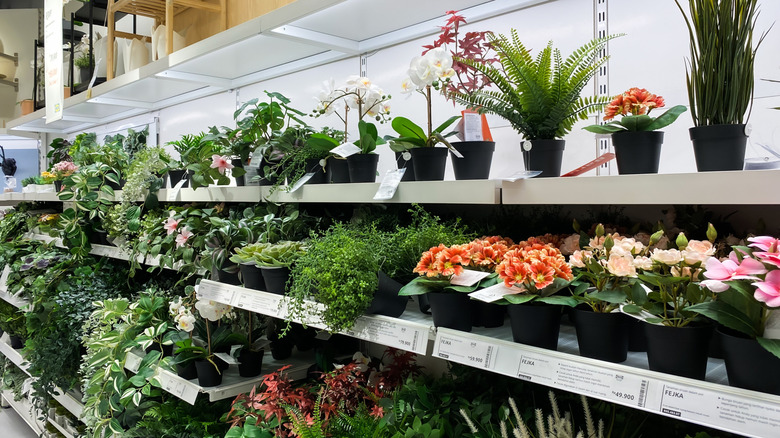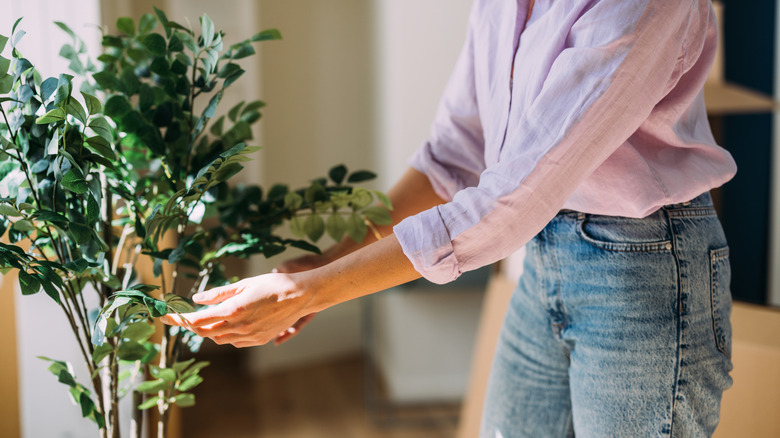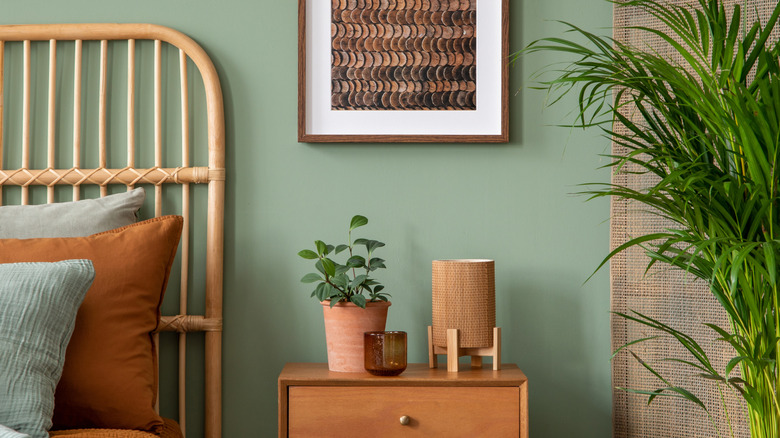Fake Plants In The Home: Evergreen Solution Or Tacky Embarrassment?
As a professional interior designer, I want you to know that you shouldn't be afraid of artificial greenery. Yes, seriously. Despite the polarizing reputation of fake plants, the advantages of incorporating artificial greenery into your home shouldn't be ignored. For those who are away from home a lot, rent their space out to others, or have an incurable case of brown thumb, artificial plants give you that pop of life and greenery in a space without the expertise that their real counterparts require. With no maintenance required other than occasional dusting, artificial plants always look great, can be moved from one home to another, and last forever. Plus, because they don't need to be placed in the perfect spot with the right amount of sunlight — personally, my fiddle-leaf fig is still moderately angry at me after five years of picking the wrong locations — fake plants can happily exist anywhere, including shaded corners or shelves that cannot support the real deal.
Sure, artificial greens don't have the same positive health benefits, such as having your living houseplants naturally clean the air. And they lacks the ever-changing cycle of growth and blooming one gets to experience with living organisms. But perhaps the worst downside to artificial plants is that many fake ones look really bad. Like, painfully tacky. I have seen offenders so terrible that they appear to be the primary cause of the poor reputation of all other artificial plants.
How do you avoid the pitfall of fake-looking fakes? Invest in high-quality options that truly look like the real thing, then stage them realistically in your home. Done correctly, most won't realize they're looking at an imposter. And that, my friends, is how you move from Tackyville, USA to chic, long-term greenery solution.
Choose shapeable, true-to-life reproductions of living plants for the most believability
Finding a believable fake plant isn't as difficult as it sounds. While the bad ones really are tasteless and unattractive, the good ones are astonishingly nice. There are two ways to attack this: Either you know the plant variety you want to showcase, or you don't. In scenario one, I always start with an image search of the real deal if I'm not 100% familiar with the nuances of that particular species. Make note of its coloration, leaf shape, structure, pot size, etc. to educate yourself on what it looks like in reality. In scenario two, simply start looking at options and when you see one you like, use an image comparison to ensure it's an accurate representation. Often, artificial plants are too saturated in color, making them instantly recognizable as fakes: Opt for options with varied muted tones, to read truer to life. Fakes are often too perfect and evenly fabricated, so look for variety in shape, texture, and color.
The most crucial piece of the puzzle is to ensure that the structure is made with a bendable metal that can be manipulated and shaped. A big reason fakes can look so jarringly artificial is because they are too perfectly formed and don't follow the laws of gravity. Pull up your trusty image comparison again and sculpt that faux nightmare into a deceptively beautiful impersonator.
Fun story: I once staged a house with a fake, stick straight bird-of-paradise that took me ages to bend into its signature sprawling, flopping shape. However, in the end, I received more messages inquiring about that plant than anything else in the house combined. The power of greenery!
Stage and style your artificial plants like you would the real deal
You've found a great-looking plant and bent it into a realistic-looking shape. Fantastic. But another misstep people take with fake plants is to place it thoughtlessly, as-is, and be done. There are some few issues here. While faux foliage can "live" anywhere, being vaguely aware of the actual conditions in which the living version would thrive makes placement more convincing. A vibrant tropical fake plant in a dark, windowless room won't ring very true. However, you also don't need an endlessly bright window, either. Just make sure the conditions are moderately plausible, and guests won't question it. Also, don't be afraid to mix fake with real greenery throughout your home. Having artificial plants interspersed with living will absolutely help blend them in, boosting overall authenticity.
Many fake plants come in utilitarian undersized pots compared to the space the real houseplant needs. For example, many fake fiddle-leaf trees come in tiny, weighted pots, whereas the real trees need room to grow. I like to place undersized pots in larger planters or baskets, fill in extra space (with foam, newspaper, or whatever you have lying around), then top with moss to give faux plants that extra-realistic touch.
Yes, investing in high-quality reproductions and upgrading artificial plant pots is more of an upfront investment, but I'd always rather see one nice-looking, properly placed, well-composed artificial plant than three lousy fakes. By taking care to get realistic artificial plants and treat them carefully, you can enjoy them maintenance-free for ages, knowing they look fabulous instead of tacky.


